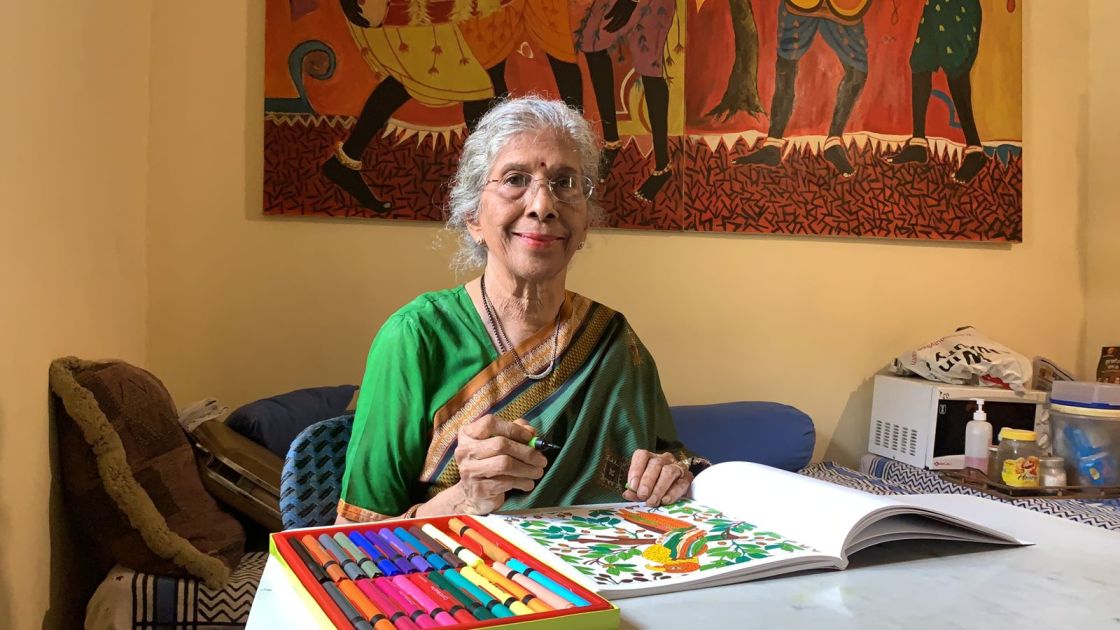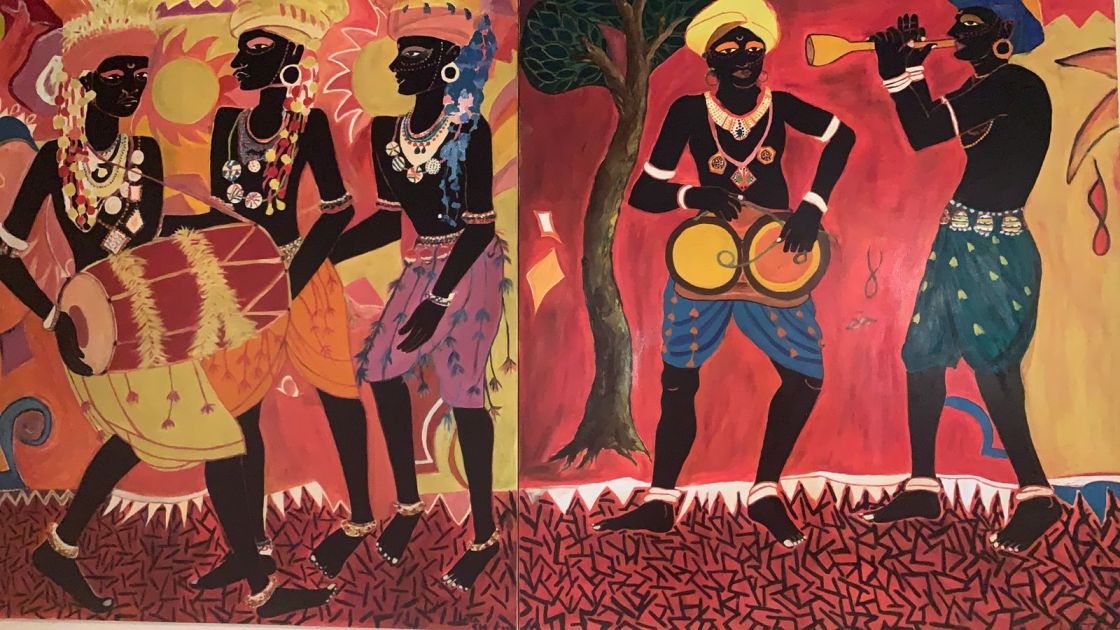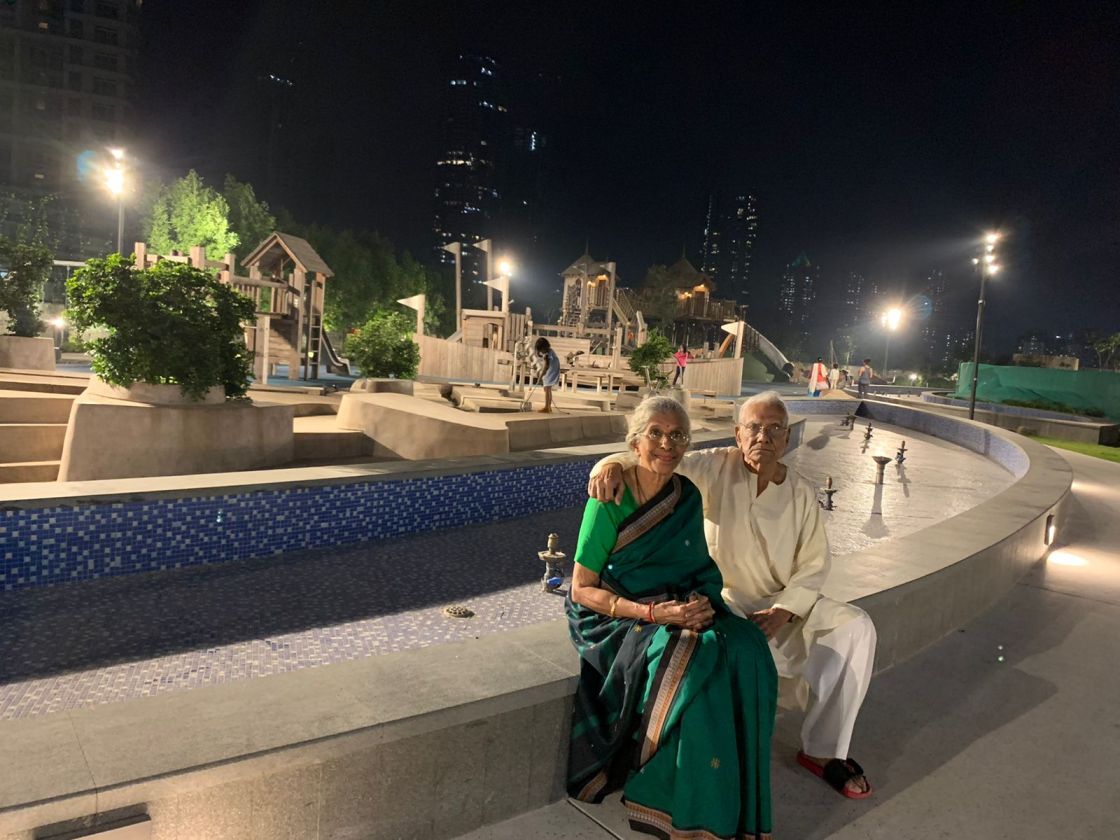Yogendra Shankar Chaudhry (87) and Lata Chaudhry (84), residents of Mumbai were married for 53 years before life as they knew it changed completely. After a series of minor incidents, Lata was diagnosed with Alzheimer’s four years ago. What should have been a peaceful existence in their 80s was shaken up by the diagnosis and the subsequent changes it brought.
Lata’s diagnosis impacted not just Yogendra, but also their son, Paresh, and their immediate family and friends who have been in constant contact with them.

While there are more than 4 million Indians suffering from some form of dementia, what’s unique about Lata’s story is how her primary caregiver and the love of her life, Yogendra, has helped her revisit a passion she nurtured as a young girl of 11. Warli paintings, a tribal art form, has her lost for hours on a single piece. The walls in their Bandra home are covered with her vibrant artwork.
“She is trying her best,” says Yogendra. The exhaustion is palpable in his tone.
He adds, “She forgets things very easily – one moment she says something and then a few seconds later she has no recollection of what she said. These are difficult times but she is my wife and of course, I will support her.”
Paresh, their son, who comes by every day to have lunch with his parents, says, “Poised and always in-control — that is how I remember amma (mother). She was never one to be fazed by any situation. Even now, there is that glint in her eyes that I see every once in a while.”
While they have help at home, Yogendra takes special care of Lata. But over the last few years, it has taken a toll on his health.
Memories of a different life

In the early 50s, Yogendra had moved to Mumbai from Uttar Pradesh in pursuit of his dream of joining Bollywood. It was during this stint that he stayed as a paying guest (PG) in Lata’s home and that is how the two first met. Recalling those moments, Yogendra says, “I don’t know about love at first sight but there was mutual liking — not just with Lata but also her family.”
He blushes when he says, “We got married in a small ceremony at the Mahalaxmi temple in Mumbai. It was a union that was blessed by all.”
He adds, “Her family was happy to have one of their daughters married off.”
Lata on the other hand was born and raised in Mumbai and belonged to a very well-respected family. Her father, Rambhau Tatnis was a noted journalist, editor and publisher of one of India’s first pre-Independence Marathi newspapers — Vividhvritta.
Lata attended the Ram Mohan English school in Girgaon and since her early years, she had displayed a keen interest in music and art. She also holds the distinction of performing with Usha Mangeshkar, Asha Bhonsle and Lata Mangeshkar’s sister. Lata was also good at painting and would often display her canvas artwork at school exhibitions.
Even though she was not trained to be an artist, she had a natural flair for it.

However, her life turned upside down when her father passed away. The situation at home changed dramatically and Lata had to drop out of college to help support the family. Here again, she turned to art and started selling her paintings and some hand-painted saris.
It is no surprise then that with her life-altering diagnosis four years ago, the only thing that Lata seemed to remember very well was her love for art and the time she had spent in her father’s home.
However, today, her memories haven’t faded but her present seems hazy. “She often asks about her mother and siblings. When I explain to her that they have all passed away, she gets upset. She asks me how it is possible for all of them to have died,” says Paresh.
Yogendra interjects here to share that one of the reasons why he became a paying guest at Lata’s home was because they needed the money and letting out a few rooms in the house meant additional income for the family.
While Yogendra came to Mumbai to become an actor he chose to marry Lata and also took up a job at Siemens. “Lata politely asked me to choose between marrying her and Bollywood, and of course, without an iota of doubt in my head, I chose her,” he says.
A fragile mind

One of the proudest artistic moments in Lata’s life was when she painted a sari for a school competition and yesteryear actor, Durga Khote was called as the judge. “Shocked with the talent reflected in my work, she promptly asked me how old I was. I said, ‘Aunty, talent has no age!’ in a matter-of-fact manner,” says Lata, mentioning that she won first prize at the competition.
She may often forget if she has eaten or if she has showered in the morning, but when she holds her brush and starts painting, she is transported to a different world. Lata can spend hours on her art and enjoys the Warli art form a great deal. The walls in their Bandra home are all adorned with Lata’s artwork. “She is the most peaceful when she is painting – it’s what she knows the best,” says Paresh.
She used sketching and painting as a coping mechanism after her father’s passing. “I always had the sensibility of using colour and used to advise my elder sister’s art students on colour combinations,” Lata reminisces.
Today, the only thing that has remained constant for Lata is Yogendra’s unflinching support. Paresh says, “We all talk about amma’s diagnosis but papa also has it tough. Being the primary care-giver is not easy and he’s not getting any younger either.” From being Lata’s biggest cheerleader to patiently answering all her questions, Yogendra refuses to give up on her. Despite Paresh living in the same city, he says that from a familiarity point of view, his mother is most comfortable in their home in Bandra where she has spent more than five decades. “She refuses to move out of this home,” adds Paresh.
There have been moments of utter chaos and fear as well in the last four years, like the time when Lata accidentally left the house. Recalling the incident Paresh says, “Papa was taking his afternoon nap when amma left the house without informing him. I remember my father being very distraught when he said he couldn’t find amma. It turned out that there was a death in the neighbourhood and she had gone to meet the family. Without thinking too much she had gone along with the family to the crematorium too. Once there, she had forgotten how she got there and what she should do to get back. Thankfully, we found her safe and sound…but that fear was something else.”
Lata’s mind has taken her back to the late ’40s, as she often talks about their old driver, Pandu, who spent considerable time with the family. She also lists the various cars that the family-owned at the time: “We had Peugeot, Plymouth, Lincoln, Chevrolet, Ford and so many more cars.”
Despite knowing that she isn’t quite herself these days, Lata refuses to get help and insists on cooking three meals even today. “Self-reliance — this is the value that amma instilled in us when we were growing up and she continues to practise it even today when her mental faculties seem to be failing her. Even now, she wakes up every single morning brimming with optimism,” says Paresh. Hearing this, Lata adds, “What’s not to love in this life?”
No comments:
Post a Comment